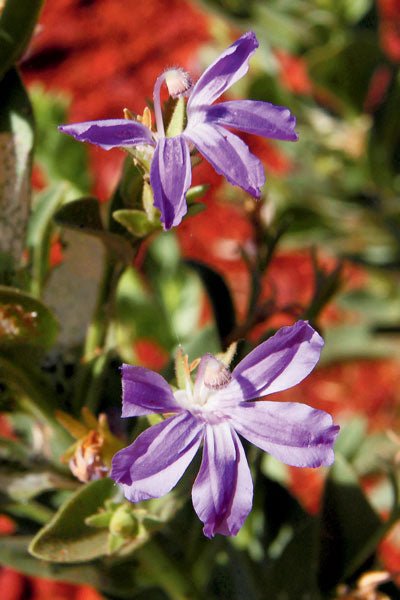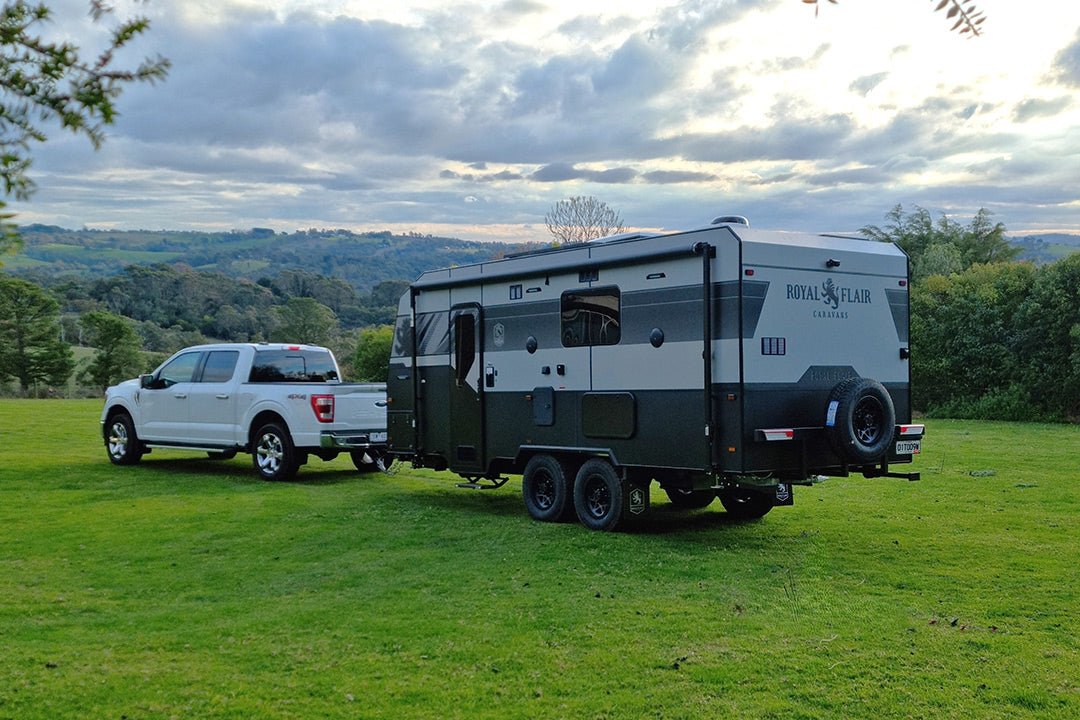MARBLE BAR, WA

‘Warmest welcome from Australia’s hottest town’, declared the sign on the outskirts as we entered Marble Bar, WA, on one of the smoothest unsealed roads we had seen in weeks. We knew instinctively that we would like this place.
Marble Bar was a ‘Tidy Town’ in 2003 and it is clear the local community take great pride in its civic appearance – bitumen seals all its roads from kerb to kerb; a nature strip runs down the centre of the main street with grass that is watered nightly and mowed weekly; a children’s playground occupies a sizeable chunk of the memorial park with a giant digital thermometer nearby so parents can keep an eye on the mercury and bring the tots inside when it gets too hot; and the local swimming pool is immaculate and would not look out of place at any five-star resort (alas, closed when we visited as it was out of season).
On arrival, we found our way to the Marble Bar Holiday Park where Margaret, the temporarily absent caretaker, had thoughtfully left a note on the reception door: “Back at 11.30. Just pick a site and make yourself at home”. We did just that, then headed to the visitor information centre, which is housed in the East Pilbara Shire Council Offices, perched on an elevated corner block surrounded by a swathe of green lawn with a neat white chain looped around its perimeter. Inside, Margaret’s granddaughter Alisia served us with a smile and loads of information about this small but surprising town.
With our pockets bulging with pamphlets, we made our way to the town’s only hotel, the Iron Clad, to deal with a thirst generated by an autumn day that was already 33°C at 11.30am and promising to get hotter still. The Iron Clad is true to its name – corrugated iron roof, walls, doors, veranda awning and window shutters. It has been an integral part of the Marble Bar social scene since its construction in 1893 and, in 2006, was listed on the Western Australian register of heritage places. Alas, when we arrived it was firmly locked against us, and indeed all comers, until noon.
The next most air-conditioned premises on the main street is the Marble Bar Roadhouse, conveniently located opposite the hotel and containing the only grocery outlet in town. We went there to stock up on some much needed supplies but found the so called ‘Mini Mart’ was more mini than mart. With only two very short aisles of shelves that stood barely shoulder high, the prospects of filling our lengthy shopping list were bleak indeed.
We did the best we could and were pleasantly surprised to find most of the fresh fruit and veggies that we craved after a week in the bush – though at a hefty price. The town’s isolation and the cost of hauling provisions over long distances (Port Hedland, the nearest major supply centre, is about 200km away) were reflected in a bill of $164 for our two small boxes of groceries. Compare some of these prices with your local Coles or Woolies – bread (frozen white) $5.85, milk (sorry, no skim) $2.75/L, avocados $4.65 each, lemons $1.50 each, bacon $34/kg, mushrooms $6.10 per punnet. Such is the reality of life in the bush! Although, in fairness, the unleaded fuel price ($1.78/L) was the lowest we had seen this side of Alice Springs – the highest was $3/L at Punmu.
HOT, HOT, HOT
Back outside, the afternoon was turning into a real scorcher so we hightailed it back to our van and cloistered ourselves there in air-conditioned comfort to consider the town’s reputation as the hottest in Australia – a reputation firmly established in the summer of 1923-24 by a world record spell of 161 consecutive days of temperatures above 100°F (37.8°C), the highest during that period being 47.5°C.
The highest temperature ever recorded in Marble Bar was 49.2°C in January 1922, though this is still well short of WA’s highest of 50.5°C at Mardie in February 1998, and the national record of 50.7°C set in 1960 by Oodnadatta, SA. But Marble Bar cops extreme heatwaves with monotonous regularity and the locals just seem to take it in their stride. As recently as the summer of 2014-15, the mercury routinely topped 45°C and nudged its own record on several occasions, prompting the Iron Clad’s manager Thomas Fox to remark somewhat stoically: “It’s Marble Bar, it’s hot all the time. We’re not expecting any more or any less people in the hotel this afternoon. In fact, I can pretty much give you all their names.”
PRECIOUS METAL
Marble Bar takes its name from a unique reef of red jasper, mistakenly thought to be marble, which crosses the bed of the Coongan River just west of the town. The mineral is a cryptocrystalline variety of extraordinarily colourful quartz believed to have been formed about 3400 million years ago. We visited the Bar in the early morning, midday and late afternoon, and never ceased to wonder at its marvellous beauty in every light.
A short distance from the Bar along the river is Chinaman’s Pool, a favourite (perhaps the only) swimming hole in town. Legend has it that a Chinese miner was lynched by the pool here when he refused to disclose the secret location of his gold strike.
The town sprang up in the Pilbara’s gold rushes in the late 1880s. Prospector Francis Jenkins discovered gold near Marble Bar itself in 1891 and his name now adorns the town’s main street. The local goldfields yielded several large nuggets, including the ‘Little Hero’ (333 ounces), the ‘General Gordon’ (332 ounces) and the ‘Bobby Dazzler’ (413 ounce), supporting a boom in population growth to over 5000 within a few years of their discovery.
By 1895, the town had its own government offices, built from local stone (these are now managed by the National Trust and still make a fine addition to the town’s architectural landscape). However, Marble Bar’s gold rush was short lived and miners soon headed south for bigger discoveries.
Keen to witness firsthand the remnants of this golden heritage, we visited the Comet Gold Mine on the outskirts of town. The mine was established in 1936 by a local prospector, Tommy Starr, who originally dubbed it ‘Halley’s Comet Mine’ supposedly because he considered it a once-in-a-lifetime strike. The mine became fully operational in 1938 and, at its peak, employed almost 200 people. Considered a paragon of industry at its time, housing was supplied for all the staff, amenities included a tennis court and a swimming pool, and the mine was the first place in WA to have AC power. Although there is still gold in the mine, it is no longer commercially viable to extract it and operations have ceased. Tours of the pit that once operated have also ceased for (lack of) public liability insurance reasons.
THE INVISIBLE
Undaunted, we drove a short distance to a small heritage museum, which turned out to be a gold mine of another kind, with a wealth of memorabilia, artefacts, gemstone and mineral displays, and some surprising facts about this small, remote town. For example, legendary aviation pioneer Charles Kingsford Smith married the daughter of a local pastoralist here in January 1923 and later took up a ‘small’ pastoral lease of 63,000 acres in the district. Some of a neighbour’s cattle strayed on to this property and were rebranded by Kingsford Smith’s father-in-law, for which crime he was reportedly sentenced to ‘imprisonment with hard labour for two years and a flogging with 12 strokes of the cat’.
Another interesting feature of the town’s history was the presence of the nearby Corunna Downs Airbase, the existence of which was one of the best-kept secrets of WWII. Dubbed ‘The Invisible’ due to its camouflage of spinifex and netting, Japanese reconnaissance planes were never able to find it and it was never referred to by name in any newspaper or radio broadcast during the war. In May 1943, a squadron of B-24 Liberator bombers left this base on the longest bombing raid flown anywhere up to that time – 1900km and 15 hours return.
Life on the base was hard for the 2000 men and women stationed here. Rations were mainly bully beef and tinned vegetables, there was no refrigeration and, during summer, showers were banned during daylight hours because the water was scalding. The RAAF personnel did enjoy a measure of relief at the Iron Clad Hotel, where a three-course meal and a glass of beer could be purchased for just two shillings and six pence.
After a couple of hot but enjoyable days, we had re-provisioned, seen all the sights in town and enjoyed a ‘chef-cooked meal’ with ice-cold beer at the Iron Clad. It was time to move on but we took with us many happy memories of this tidy, friendly little Pilbara community on the edge of the Western Desert.
FAST FACTS
Getting there
Marble Bar is in Western Australia’s East Pilbara region, 202km south-east of Port Hedland along the sealed Port Hedland Road and around 300km north of Newman along the unsealed Marble Bar Road.
Activities
- Walking the Marble Bar
- Swimming at Chinaman’s Pool
- Visiting the Marble Bar Museum
More info
- Marble Bar has an arid climate with extremely hot summers and mild-to-warm winters. The best time to visit is between May and September.







